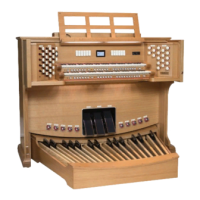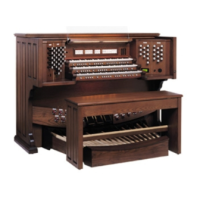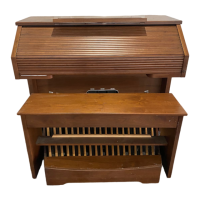Do you have a question about the Rodgers Insignia 537 and is the answer not in the manual?
Details the function and operation of the Knob MIDI Tx parameter for MIDI transmission.
Explains the operational ranges for Melody and Bass couplers and how to set the split point.
Provides instructions on how to adjust the split point for couplers on the Great manual.
Details potential radio and television interference and corrective measures.
Provides copyright information and disclaimers regarding manual content.
Explains the meaning of warning symbols (e.g., CAUTION, WARNING) used in the manual.
Guidelines for connecting and using the unit's power supply safely and effectively.
Recommendations for optimal and safe placement of the unit to avoid interference and damage.
Instructions on how to properly clean and care for the organ's finish and components.
Covers essential precautions for operation, data protection, and handling.
Guidance on connecting and using headphones with the instrument.
Explains the manual's structure and how to navigate its sections effectively.
Illustrates and identifies the main controls on the organ's console for easy reference.
Step-by-step guide for connecting the power cord and pedal cable to the instrument.
Instructions on how to attach the supplied music stand to the organ.
Instructions on how to use the key to lock and unlock the organ's rolltop cover.
Explains the different manuals (keyboards) and the pedalboard of the organ.
Provides the procedure for powering the organ on and off, including self-diagnostic tests.
Details how to adjust the overall volume and individual division volumes using the rotary controls.
How to activate and use the built-in demo songs to showcase the organ's sounds.
Explains how to select and activate individual organ stops (voices) to produce sound.
Introduction to couplers and their function in linking divisions and enabling new sounds.
Details how intermanual couplers connect divisions to play stops from different manuals.
Explains the Melody coupler's function for accentuating melody notes while playing accompaniment.
Describes the Bass coupler, which adds a pedal part to notes played on the Great manual.
How to quickly clear activated stops and couplers using the [0] piston.
Guides on saving combinations of stops, couplers, and settings as registrations.
Explains the 8 pistons available for storing general or divisional memories and their function.
Procedure for saving custom registrations to memory banks (M1, M2, etc.) for quick recall.
How to choose and recall previously saved registration memories from different banks.
How to use the expression pedal for volume control or crescendo effects.
Functionality to change the instrument's pitch to match other instruments or player preference.
Explains tremulants, their effect on volume, and how they control stops in specific divisions.
How to quickly engage a full organ registration without canceling the current settings.
Introduction to ORCH/MIDI couplers for accessing orchestral voices or controlling external MIDI devices.
Details on using internal orchestral voices, playable alone or with organ stops.
Explains how MIDI couplers transmit commands to external sound modules or sequencers.
Describes the organ's informative display and the controls used to access and modify settings.
Overview of adjustable parameters like Temperament, Reverb Type, Tremulant Rate and Depth.
How to adjust the organ's pitch (tuning) to match external instruments or for specific musical needs.
Detailed explanation of the Melody and Bass couplers and their effect on organ sound.
Categorization of organ stops into families like Principals, Flutes, Strings, and Reeds for understanding their roles.
Explanation of stop designations in 'feet' and their relationship to concert pitch.
Description of Celeste ranks and their unique tuning quality for creating lush textures.
Explains how intermanual couplers allow stops from one division to be played on another keyboard.
Procedure for selecting and playing internal orchestral voices available on the organ.
How to select and adjust the digital Reverb effect for different ambient sounds like rooms or halls.
Details how the expression shoe controls swell effects and/or the Crescendo function.
How to adjust the 'Organ Brilliance' parameter to control the brightness of the organ's sound.
Information on historical and modern temperaments and how to select them.
Steps to choose and set one of the available temperaments for authentic historical tuning.
Configures whether the Great and Pedal divisions are affected by the expression shoe.
Procedure to save current menu settings as the default, retained after power off.
A comprehensive list of all organ stops, divided by division, with SysEx code assignments.
Setting to specify if the physical TUNING knob position is read on power-on.
Location and function of the headphone jack, which mutes internal speakers.
Details on connecting external audio devices and routing audio signals to amplifiers or recorders.
Introduction to MIDI couplers for controlling external MIDI devices and accessing orchestral voices.
Steps to configure ORCH/MIDI tabs to function as MIDI couplers for external sound modules.
Overview of accessible MIDI parameters for controlling external sounds via ORCH/MIDI couplers.
Explains how to set MIDI channels for couplers to control different external sounds independently.
How to select specific instrument tones (sounds) from external MIDI modules using shortcuts or numbers.
Using keyboard shortcuts to select MIDI tones by activating ORCH/MIDI tabs and pressing keys.
Procedure to select MIDI tones by entering specific Program Change and Bank Select numbers.
How to save selected MIDI sounds to piston memories for immediate recall with organ registrations.
Adjusting the octave of sounds controlled by MIDI couplers up or down by one or two octaves.
Information on General MIDI and GS Format standards for sound module compatibility and expansion.
Controlling MIDI sound attack and loudness via fixed values, expression pedal, or keyboard touch.
How to position instruments within the stereo field using the Pan message for spatial audio effects.
Using the expression shoe to dynamically control the velocity (volume/attack) of MIDI notes.
Using keyboard touch velocity to control MIDI sound dynamics, similar to a piano.
Setting an independent Reverb level for each MIDI coupler to add ambience.
Setting an independent Chorus level for each MIDI coupler to add pitch fluctuation and depth.
Configuration of global MIDI settings affecting the entire organ, independent of individual couplers.
How to send an 'All Notes Off' message to reset external MIDI equipment.
Explanation of reserved MIDI channels for organ divisions and their transmission status.
Procedure to set the status (Send/Receive, Send only, Receive only, Off) for MIDI Master channels.
How registration information is transmitted and received via MIDI for controlling other organs or sequencers.
How the organ responds to sequencer Start/Stop/Continue messages for recording registration status.
Information on connecting sequencers or sound modules using the organ's MIDI IN/OUT/THRU jacks.
How to save temporary MIDI settings as defaults to be retained after the organ is powered off.
Procedure for saving organ memory banks to an external MIDI sequencer and reloading them.
Steps to save the organ's memory bank contents to a sequencer for backup.
Instructions on loading previously saved memory banks from a sequencer back into the organ.
How to reset all piston memories to their original factory-set states.
Procedure to restore all organ settings (piston and global memory) to their original factory defaults.
Tips for cleaning and protecting the organ's console and pedalboard from damage.
Instructions for cleaning the keyboards and stop tabs, advising against solvent use.
Comprehensive technical specifications including dimensions, power, speakers, and connectivity.
Canadian compliance statement for digital apparatus regarding interference.
French translation of the Canadian notice regarding interference.
| MIDI | Yes |
|---|---|
| Pedalboard | 32-note |
| Amplification | External (Requires external amplification system) |
| Speakers | External (Requires external speaker system) |
| Dimensions | Varies depending on console configuration |
| Weight | Varies depending on console configuration |


